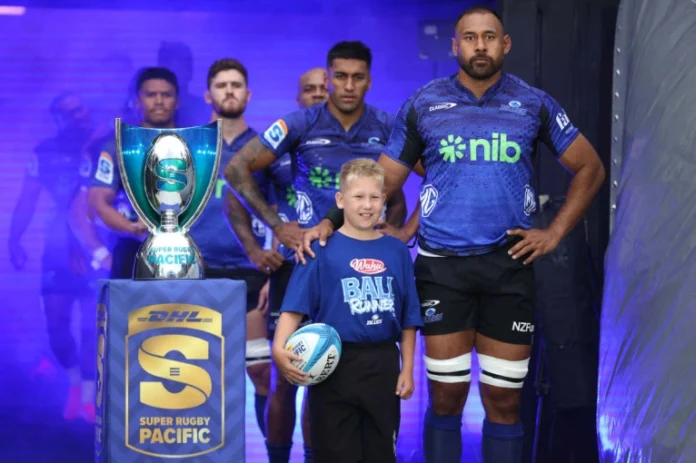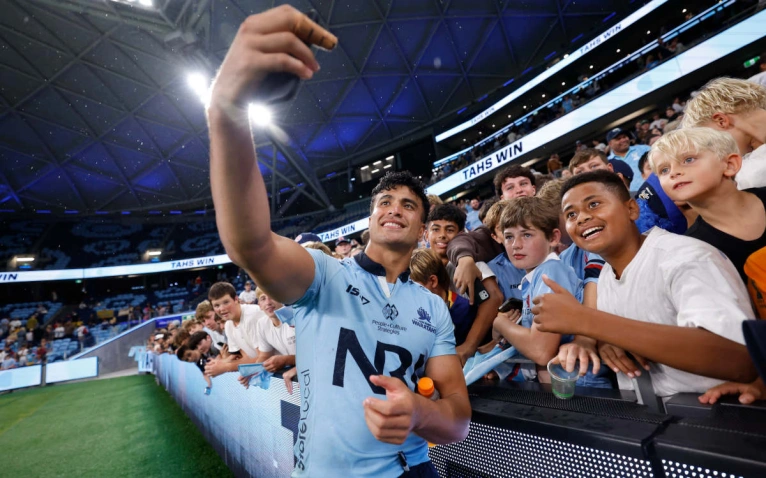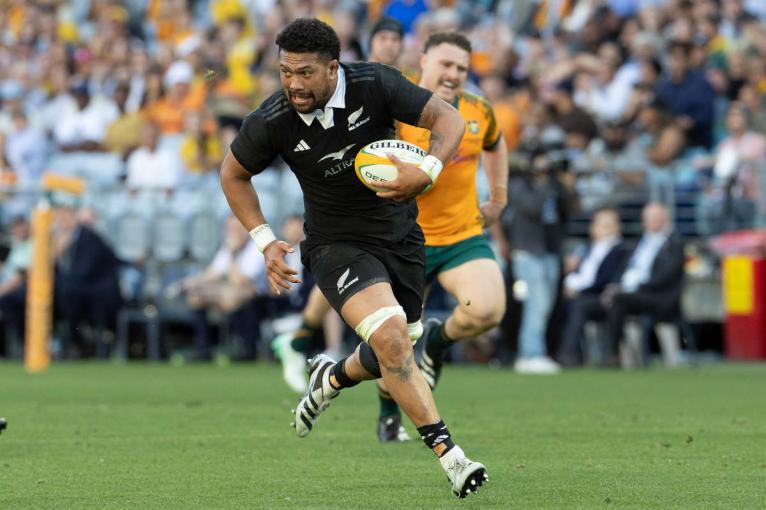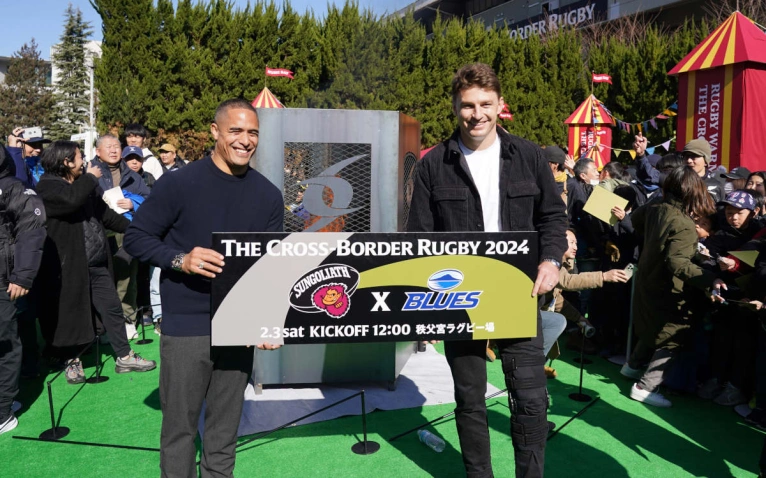
[ad_1]
Super Rugby must be wondering if the clock is being wound back to the good old days. The positive news keeps rolling in for a competition that was once the envy of the world in the early days of professionalism but has known nothing but negativity for the last decade.
There is a profound sense of optimism abounding about what might happen in 2025 after the opening weekend produces surprise results, epic contests, quality rugby and big turnouts.
There were 25,000 people at Eden Park to watch a rematch of last year’s final between the Blues and Chiefs, 15,000 in Christchurch to see the Crusaders beat the Hurricanes and 16,000 in Sydney where the Waratahs showcased new signing Joseph Sua’ali’i.
These are strong numbers comparatively for an opening weekend – one which produced three wins for the three Australian teams in action – and suggested that after all the upheavals of recent years to reshape the competition as a Pacific tournament, the audience is finally buying in.
More than 25,000 fans in Auckland turned out to watch the Blues versus the Chiefs (Photo MICHAEL BRADLEY/Getty Images)
What will have helped enormously was the unexpected praise from Sua’ali’i, the man signed from the NRL in a $1.5m-a-year-deal and who made his Wallabies Test debut last year at Twickenham.
He said, after helping his team to a last-minute 37-36 win over the Highlanders: “I reckon the intensity was more here in Super Rugby (than Test rugby) if I’m being quite honest.
“I was talking to (Waratahs captain) Jake Gordon about it; just the ball in-play, the contact and the Highlanders boys were ready to play today.
“I got hit a couple of times, but it was good. It’s a high level of footy we’re playing here, especially against those Kiwi boys…I’m just glad we got the win.”
Prior to the season kicking off, there were also number of big-ticket good news items to support the feeling that Super Rugby may be on the cusp of a resurgence.
The Wallabies finished 2024 a different team to the one they were when they met Wales in July and even Australia’s hardest to please critic, David Campese, went from being a Joe Schmidt doubter to convert in the space of a few months.
Rugby Australia has secured a vastly improved broadcast contract which will see the national union lift its current AU$29m a year from Channel Nine to $42m a year with the prospect of more to come.
According to reports, the deal will have performance elements to it that will be linked to Wallabies victories.
In 2023, even at the start of last year, no one would have imagined that such a kicker would yield much, if anything, such was the shambolic state of Australian rugby, but now, maybe that could be quite the unexpected source of income.
The Wallabies finished 2024 a different team to the one they were when they met Wales in July and even Australia’s hardest to please critic, David Campese, went from being a Joe Schmidt doubter to convert in the space of a few months.
 Joseph-Aukuso Suaalii said the intensity in Super Rugby was higher than the Test game (Photo by Darrian Traynor/Getty Images)
Joseph-Aukuso Suaalii said the intensity in Super Rugby was higher than the Test game (Photo by Darrian Traynor/Getty Images)
Schmidt has rebuilt a solid foundation and will stay on until the end of the Rugby Championship – which has given Rugby Australia an extended period in which to find a replacement.
Rugby remains a minority sport in Australia but the prospect of it growing and winning the hearts and minds of more people is infinitely higher now than it was two years ago.
The good news in New Zealand has mostly come out of Moana Pasifika, who not only secured their financial future late last year when the club found new backers, but they also managed to pull off the steal of the century when they signed Ardie Savea.
It was a huge coup for a club that spent its first two seasons living off the smell of an oily rag and which has struggled to make any impact.
Now Moana have money, a permanent home – they will be playing at North Harbour Stadium in Auckland – a settled coaching team led by Tana Umaga and an iconic leader in Savea.
The arrival of Savea has been a game-changer not just in what he will deliver as one of the world’s best players, but in the wake of his decision, there is now expected to be a few more big-name players willing to follow suit and join him at Moana.
It all seems that it is working out for Super Rugby in a way no one could have imagined even last year when the Rebels were bankrupt, Moana were on their way there, and the Australian public were so bemused by the Wallabies that there was even talk of telling the Lions not to come.
Moana’s chief executive Debbie Sorenson told the NZ Herald that at least two current All Blacks have signalled they want to join the club in 2026.
It all seems that it is working out for Super Rugby in a way no one could have imagined even last year when the Rebels were bankrupt, Moana were on their way there, and the Australian public were so bemused by the Wallabies that there was even talk of telling the Lions not to come such was the fear of the tour being a one-sided farce.
But one major question remains unanswered for Super Rugby in early 2025. The competition can’t realistically remain in an 11-team format longer-term.
An odd number of teams makes the draw convoluted and messy and Super Rugby will run for a week longer this year despite having fewer games – a scenario that neither the players nor broadcasters much like.
Each team has to have two bye weeks and it’s a tough sell when the opening weekend doesn’t feature one team – in this case it was the Reds who sat out.
 Moana Pacifika have a permanent home in Auckland, financial security and have signed superstar Ardie Savea (Photo by Steve Christo – Corbis/Corbis via Getty Images)
Moana Pacifika have a permanent home in Auckland, financial security and have signed superstar Ardie Savea (Photo by Steve Christo – Corbis/Corbis via Getty Images)
What’s the fix, though? New Zealand, despite its seemingly inordinate player depth, doesn’t have the fan base, facilities or finances to support another team.
Fiji and the Pacific Islands are a non-starter for another team and Australia has finally got itself down to four teams and will have no appetite to increase that number given the difficulties it has previously had trying to run five.
The alternative route to an even number is to reduce to 10 times – but this is just as fraught. The Drua have been one of the success stories of the last few years, Moana are now on a stable footing and the Australians would face a political nightmare trying to decide which of their four teams to cut if they had to.
There was a suggestion last year that the Jaguares were being lined up to return, but that is an idea dead on arrival.
There are no direct flights to Argentina from New Zealand anymore, and few believe bringing back the Jaguares would fit the fan friendly brief the competition is now ruled by.
A more realistic solution is finding a way to reconnect with Japan – the Sunwolves joined the competition in 2016 and were there until 2020 – something that Beauden Barrett called for last week.
“I’d love to see the Japanese become part of the competition. I feel like we need to grow the competition and that would be great.
Why would Japan even consider a return to Super Rugby? There is no appetite – either in New Zealand and Australia or Japan – to recreate a separate team like the Sunwolves to sit as a sole representative in Super Rugby.
“It’s the travelling, the experiences you have off the field, but also the stadiums, the different environments you play in, that’s what makes you a good player.
“And it’s those sorts of things that keep players who have been around a bit more interested and excited to get back up for another season.”
But why would Japan even consider a return to Super Rugby? There is no appetite – either in New Zealand and Australia or Japan – to recreate a separate team like the Sunwolves to sit as a sole representative in Super Rugby.
The alternative idea would be to shift their season to start earlier and have the top three or five teams qualify to play in Super Rugby.
But the Top League is booming, so why change it? Former All Blacks captain Sam Cane, who plays for Suntory Sungoliath, says: “It would decimate the comp (if Japan linked its Top League with Super Rugby).
 Beauden Barrett has suggested a Japanese team to replace the Sunwolves in Super Rugby Pacific but not everyone is convinced (Photo Toru Hanai/Getty Images)
Beauden Barrett has suggested a Japanese team to replace the Sunwolves in Super Rugby Pacific but not everyone is convinced (Photo Toru Hanai/Getty Images)
“The top teams over here would compete well with the bottom half of the Super Rugby table.
“I don’t think they would compete well with the top half and the bottom teams I don’t think they would be close and there would be some real blowouts.
“A lot of the Japanese squads the starting 23 are good players high level, but if you get a few ideas the standard drops down because they don’t have a lot of development rugby. Super Rugby squads get tested, but they don’t have the same depth.”
While the format may not be perfect, the opening weekend has suggested that having one less team than last year has condensed the talent pool and closed the gap between the top and bottom teams.
Super Rugby is bouncing back, but it appears stuck with 11-teams for the foreseeable future. That’s one problem it is unlikely to be able to fix quickly but it may, in fact, be a blessing in disguise.
While the format may not be perfect, the opening weekend has suggested that having one less team than last year has condensed the talent pool and closed the gap between the top and bottom teams.
And this looks destined to deliver a more gripping, higher quality competition which has an opportunity to use these next few years to grow its fan base, win back trust and open its expansion options for 2030.
[ad_2]
Copyright for syndicated content belongs to the linked Source link

